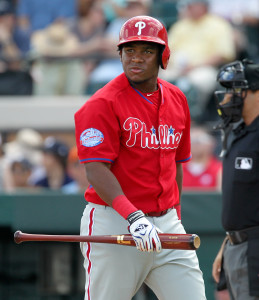Fantex, Inc. announced today that it has entered into brand contracts with five Major Leaguers: Phillies third baseman Maikel Franco, Astros right-hander Collin McHugh, Orioles second baseman Jonathan Schoop, Twins right-hander Tyler Duffey and Padres third baseman Yangervis Solarte (as noted on BusinessWire.com).
Fantex offers professional athletes an up-front, one-time payment in exchange for a portion of that player’s future earnings both on and off the field. Fantex then sells “shares” of that player to public investors for a set price (thus covering the up-front payment to the player), allowing those investors to turn a profit if said player crosses a certain threshold in his career earnings. Obviously, that creates risk for the investors, who stand to take a financial loss if the player fails to earn enough money in his career to justify the shareholders’ investment. Angels left-hander Andrew Heaney became the first player to enter into an agreement with Fantex last September, taking a $3.34MM up-front payment in exchange for 10 percent of his future earnings. (Notably, the league and the MLBPA each approved that agreement, and Fantex’s announcement seemingly suggests that the same is true of these five agreements.)
As for the new wave of Fantex additions, Schoop secured the largest sum, agreeing to an up-front payment of $4.91MM. Franco, meanwhile, will earn $4.35MM, while McHugh will take home $3.96MM, Solarte will take home $3.15MM and Duffey will earn $2.23MM. Notably, Solarte’s agreement is for 11 percent of his “brand,” while the other four (and Heaney) signed away 10 percent.
With six big leaguers now on board in addition to 14 athletes from other sports, it stands to reason that the number of professional baseball players willing to enter into such agreements will increase. It’s an interesting proposition for Major Leaguers — not entirely dissimilar from agreeing to an early contract extension; in essence, the players in question are taking a life-changing sum of money early in their career in exchange for limiting their earning capacity once they’ve navigated through their arbitration years and entered their free-agent seasons. Those same principles are all true of players that sign contract extensions, though the extent of the up-front sum and the long-term risk obviously vary.
Beyond the long-term impact on a player’s earnings, it also seems plausible that players who enter into agreements with Fantex could be less likely to sign long-term extensions with their current club. Extensions, after all, are most often signed to provide a player with his first fortune in exchange for giving the club a discount rate on would-be free-agent or arbitration seasons. Heaney, Franco, McHugh, Schoop, Duffey and Solarte, though, have each secured a sizable sum without altering their free agency timelines, thereby creating less urgency to sign an extension. (It should be noted, too, that players like Duffey and Solarte aren’t necessarily obvious extension candidates in the first place.) It seems reasonable to expect that some players and agents will view Fantex as a means of locking in that first payday while preserving the right to get to free agency at a younger age. In a market that places a premium on youth — as evidenced by contracts signed by Jason Heyward, Justin Upton, Mike Leake and others — that comes with significant benefit.
The payments from Fantex, of course, are smaller than the sums that we’ve seen players haul in via contract extensions, but the trade-off that Fantex players face early in free agency figures to be more minimal than the trade-off of their peers that sign extensions. For instance, Giants lefty Madison Bumgarner will reach six years of Major League service time this season, but he remains under control for three more seasons; he’s guaranteed $11.5MM in 2017 and has a pair of $12MM club options on each of the two subsequent seasons. Bumgarner’s contract guaranteed him $35MM ($57.5MM if each of those options is exercised), but he’ll earn a maximum of $35.5MM over what would have been his first three free-agent seasons — a fraction of what he could earn were all 30 teams allowed to bid on him. Bumgarner’s open-market annual value could be $25MM or more over the life of a six- or seven-year term. Ten percent of a theoretical $150-175MM contract is a smaller loss for the player than the difference between the free-agent seasons on an extension and the aforementioned market value.
I should note that this isn’t a knock on Bumgarner’s contract by any means — it was a record-setting deal for a pitcher in his service class and comes with the same potential risk/reward that many early extensions carry. Conversely, Jon Singleton locked in $10MM and has yet to see his big league career get off the ground. If Singleton never develops into an MLB-caliber hitter, he’ll receive significantly more than he would have by entering into a Fantex deal. Balancing that risk and reward is likely something with which players and their agents will wrestle if Fantex agreements continue to increase in popularity.
From a more general standpoint, there’s quite a bit we don’t know about the finer details of Fantex. The method by which each player’s up-front valuation is determined, for instance, isn’t known. Accurate reporting of off-field income (e.g. endorsements) would be paramount (and is presumably mandated within the contract agreements), and the unproven model in question seemingly only works if Fantex is able to raise enough investor funding to finance the initial payment to the player. This is all relatively new territory, though, and additional information pertaining to the new opportunity for pro athletes should become increasingly available in the months to come.

